Bloom's Taxonomy Teaching Resources
Use this collection of Bloom's Taxonomy-related teaching resources when working in your classroom within the Bloom's framework to promote higher-order thinking among your students. Resources provided include display posters, question/sentence starter cards, and fast finisher task cards.
Curious about the background of this higher-order thinking framework and the man behind it all? Read on for a primer from our teacher team!
What Is Bloom's Taxonomy?
Bloom's Taxonomy is a framework for organizing and categorizing different types of learning objectives that's long been popular in education. It was developed by an educator named Benjamin Bloom and his colleagues back in the 1950s and revised by a group of cognitive psychologists, curriculum theorists and instructional researchers, and testing and assessment specialists in 2001.
The framework is based on the idea that there are different levels of cognitive processing, and that each level builds on the previous one. Bloom (and his colleagues) originally had 6 levels of his taxonomy, and those were kept in the revision but broken down into 19 specific cognitive processes to further clarify the original 6.
What Are the Bloom's Taxonomy Levels?
The original taxonomy consists of six levels, arranged in a hierarchical order:
- Remembering: Recalling information from memory
- Understanding: Comprehending the meaning of the information
- Applying: Using the information in a new context
- Analyzing: Breaking down the information into parts and understanding the relationships between them
- Evaluating: Making judgments about the value or quality of the information
- Creating: Using the information to generate new ideas or products
Since the 1950s when it was created, the taxonomy has been used by educators to design lesson plans and assessments, and it's also used outside the education space by businesses to design training programs.
The taxonomy can be used by teachers evaluate learning outcomes, as it helps to ensure that the education and training are in line with the goals of the learner and that the learner is able to understand, analyze, evaluate and create using the knowledge acquired.
How Do You Use Bloom's Taxonomy in the Classroom?
Curious about how to use Bloom's Taxonomy in your classroom to help students develop higher-order thinking skills and to design effective lesson plans and assessments? Here are a few examples of how it can be used:
- Writing learning objectives: Use the framework to write clear and measurable learning objectives for your lessons that ensure your lesson is aligned with the goals of the learner and your students will be able to understand, analyze, evaluate and create using the knowledge acquired.
- Planning lessons: Teachers can use the taxonomy to plan lessons that engage students in different levels of cognitive processing. A lesson on a historical event, for example, might begin with a review of the basic facts (remembering) and then move on to an analysis of the causes and consequences of the event (analyzing).
- Creating assessments: Teachers can use Bloom's Taxonomy to create assessments that measure students' understanding and ability to apply, analyze, evaluate, and create. Instead of asking students to recall facts, a teacher might probe deeper, asking them to analyze a text, evaluate an argument, or create a solution to a problem.
- Encouraging critical thinking: Teachers can use Bloom's taxonomy as a guide to encourage students to think critically. By asking questions that prompt students to analyze, evaluate, and create, teachers can help students develop the skills they need to think critically.
In general, Bloom's Taxonomy should be used in classrooms as a guide and not as a rigid set of rules — it's always good to be flexible and adaptable to the needs of the learner.
Who Was Benjamin Bloom?
Curious about the man behind the method? Benjamin Bloom was an American educational psychologist who made significant contributions to the field of educational psychology. He is best known for his work on Bloom's Taxonomy, but it wasn't all he did in his life!
Bloom received his Ph.D. in education from the University of Chicago in 1942 and then worked as a professor of education and psychology at the University of Chicago and the University of Illinois. It was there that he conducted research on a wide range of topics, including educational measurement, teaching methods, and the development of critical thinking skills.
In the 1950s, Bloom led a team of researchers who developed his now world-famous Bloom's Taxonomy, which was first published in 1956 in the book "Taxonomy of Educational Objectives: The Classification of Educational Goals."
Bloom also conducted research on the mastery learning method, in which students are provided with additional instruction and practice until they have mastered a particular skill or concept. His work on mastery learning has been applied across a variety of fields, including education, psychology, and business management.
Bloom's work — including this taxonomy – has had a significant impact on the field of education.
- Plus Plan
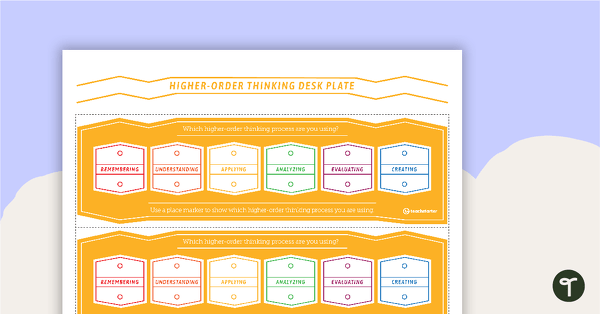
Higher-order Thinking Bloom's Taxonomy Desk Plates
A simple and highly effective desk plate that makes higher-order thinking visible and encourages cognitive thinking.
- Plus Plan
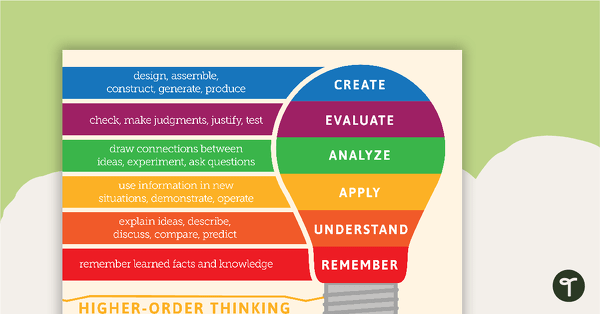
Higher-order Thinking | Bloom's Taxonomy Poster
A vibrant poster that shows the six higher-order thinking skills and a visual reminder of the process of thinking critically and creatively.
- Plus Plan
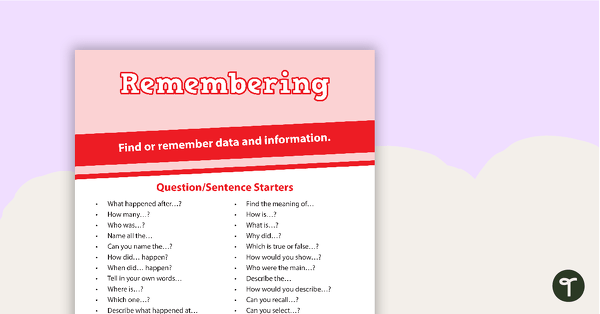
Bloom's Taxonomy Sentence Starters and Activities Posters
A set of six posters examining Bloom's Taxonomy.
- Plus Plan

HOT (Higher Order Thinking) Questions Wall
Higher Order Thinking signage material and page borders to use in conjunction with Bloom's Taxonomy.
- Plus Plan
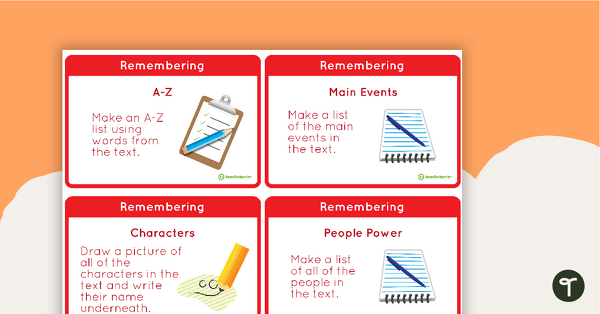
Bloom's Taxonomy Fast Finisher Task Cards - Lower Grades
32 Bloom's Taxonomy fast finisher activity cards.
- Plus Plan
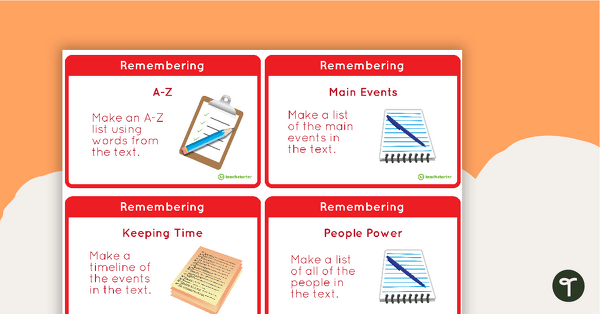
Bloom's Taxonomy Fast Finisher Task Cards - Middle Years
44 Bloom's Taxonomy fast finisher activity cards.
- Plus Plan
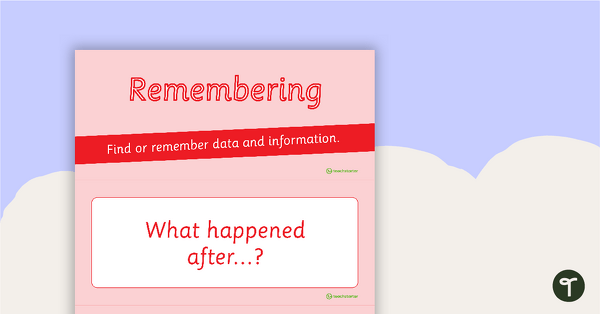
Bloom's Taxonomy Question/Sentence Starter Cards
A set of reading question and sentence starter cards aligned with Bloom's Taxonomy.
- Plus Plan
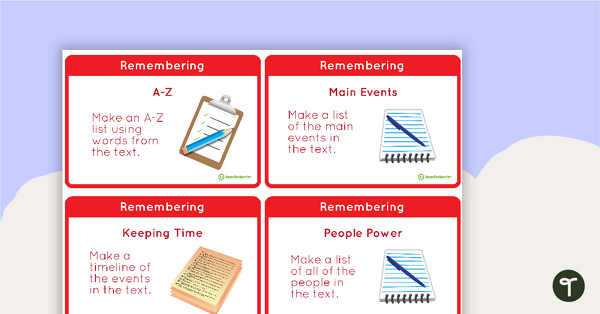
Bloom's Taxonomy Fast Finisher Task Cards - Upper Grades
44 Bloom's Taxonomy fast finisher activity cards.
- Bloom's Taxonomy Task Cards
- Bloom's Taxonomy Posters
- Bloom's Taxonomy Labels Signs Decorations
- Bloom's Taxonomy Desk Plates
- Bloom's Taxonomy Labels
- Bloom's Taxonomy for Kindergarten
- Bloom's Taxonomy for 1st Grade
- Bloom's Taxonomy for 2nd Grade
- Bloom's Taxonomy for 3rd Grade
- Bloom's Taxonomy for 4th Grade
- Bloom's Taxonomy for 5th Grade
- Bloom's Taxonomy for 6th Grade
- Bloom's Taxonomy for 7th Grade